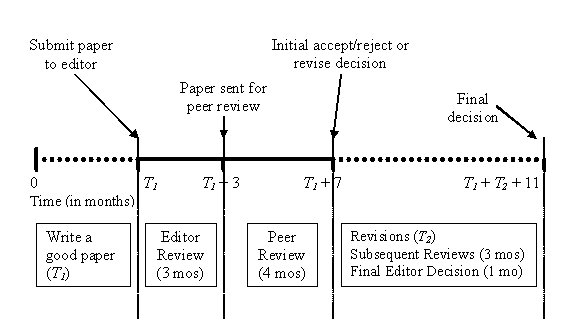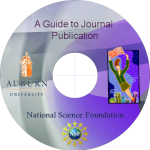

Publication Timeline
The publication processing time involves many time consuming steps. The following information was extracted from the Survey sent to the engineering journal editors. Consider the table and figure:
- The editor spends several months processing, reviewing, and distributing the paper to reviewers. A submitted paper may be sent out for review by the editors anytime up to 5 months from receipt, with the largest percentage sent out after 1 to 3 months from submittal.
- Most of initial peer reviews require less than 6 months but reviews can easily take one year or more. Some reviewers fail to review the paper at all (despite committing to do so) which can further delay the review process as the editor must first wait for the errant review, then quickly find another review if there are not enough in hand (most journals require two or more peer reviews).
- Upon completion of all reviews and revisions, the majority of editors make a final accept/reject decision in less than one month.
- The total review decision time (including all revisions) ranges from less than 6 months to 2 years. Approximately, 80% of all papers require 6 to 18 months before an acceptance decision is reached.
- Needless to say, the more review cycles, the longer the review process. Though second (and third) reviews of revised papers usually go quicker than the initial (first) review, these still take months.
- Once a paper is accepted it gets in queue for publishing, which can add one to three years beyond acceptance before the article appears in print.
The tables below show the range of months in the second column under each action while the first column shows the corresponding percent of editor's responses falling within that number of months.
|
Initial |
Initial |
Editor |
|||
|
Editor Review |
Peer Review |
Decision |
|||
|
23% |
< 1 |
17% |
< 2 |
74% |
< 1 |
|
43% |
1
- 3 |
43% |
2
- 4 |
11% |
1
- 3 |
|
29% |
3
- 5 |
26% |
4
- 6 |
3% |
3
- 5 |
|
3% |
5
- 7 |
6% |
6
- 8 |
9% |
5
- 7 |
|
3% |
NA |
3% |
>
8 |
3% |
NA |
|
|
|
6% |
NA |
|
|
|
Total Review Time |
Accepted Papers |
||
|
(including revisions) |
to Print |
||
|
14% |
<
6 |
34% |
<
6 |
|
43% |
6
- 12 |
49% |
6
- 12 |
|
34% |
12
- 18 |
9% |
12
- 18 |
|
3% |
18
- 24 |
3% |
18
- 24 |
|
6% |
NA |
6% |
NA |

Results from table indicate that the average initial editor review process takes 3 months, the first peer review process takes 4 months, subsequent revisions take 3 months, and the final editor decision takes 1 month. Assuming it takes time T1 to research, develop, and write a good paper, and T2 to prepare the necessary paper revisions, the entire paper processing time from initial development to final acceptance takes (T1 + T2 + 11) months. Assuming a reasonable estimate for T1 = 6 months and T2 = 3 months, the entire processing time for one paper is 20 months. Novice researchers need to be cognizant of this lengthy timeline, especially considering that tenure decisions usually occur at the end of year 5. A one- or two-year delay in research and authorship responsibilities can irreparably harm an academic career. The figure also stresses the importance of extracting papers from the dissertation and/or collaborating with colleagues. The quicker a good paper "hits the street, the faster it can drive home."
